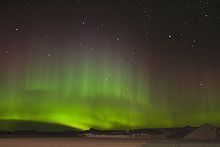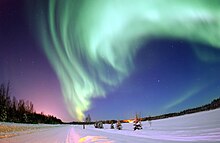
In northern latitudes, the effect is known as the aurora borealis (or the northern lights), named after the Roman goddess of dawn, Aurora, and the Greek name for the north wind, Boreas, by Pierre Gassendi in 1621. The chance of visibility of the aurora borealis increases with proximity to the North Magnetic Pole.Auroras seen near the magnetic pole may be high overhead, but from farther away, they illuminate the northern horizon as a greenish glow or sometimes a faint red, as if the Sun were rising from an unusual direction. The aurora borealis most often occurs near the equinoxes. The northern lights have had a number of names throughout history. The Cree call this phenomenon the "Dance of the Spirits". In Europe, in the Middle Ages, the auroras were commonly believed a sign from God.
Its southern counterpart, the aurora australis (or the southern lights), has similar properties, but is only visible from high southern latitudes inAntarctica, South America, or Australasia. Australis is the Latin word for "of the South".
Auroras can be spotted throughout the world and on other planets. They are most visible closer to the poles due to the longer periods of darkness and the magnetic field.


In Bulfinch's Mythology from 1855 by Thomas Bulfinch there is the claim that in Norse mythology:
- The Valkyrior are warlike virgins, mounted upon horses and armed with helmets and spears. /.../ When they ride forth on their errand, their armour sheds a strange flickering light, which flashes up over the northern skies, making what men call the "aurora borealis", or "Northern Lights".
While a striking notion, there is not a vast body of evidence in the Old Norse literature supporting this assertion. Although auroral activity is common over Scandinavia and Iceland today, it is possible that the Magnetic North Pole was considerably further away from this region during the centuries before the documentation of Norse mythology, thus explaining the lack of references.
The first Old Norse account of norðrljós is found in the Norwegian chronicle Konungs Skuggsjá from AD 1230. The chronicler has heard about this phenomenon from compatriots returning from Greenland, and he gives three possible explanations: that the ocean was surrounded by vast fires, that the sun flares could reach around the world to its night side, or that glacierscould store energy so that they eventually became fluorescent.
In ancient Roman mythology, Aurora is the goddess of the dawn, renewing herself every morning to fly across the sky, announcing the arrival of the sun. The persona of Aurora the goddess has been incorporated in the writings of Shakespeare, Lord Tennyson and Thoreau.
An image of an aurora was used as part of the emblem for the 1994 Winter Olympics in Lillehammer.
English author Philip Pullman's trilogy of novels, His Dark Materials, explores the nature of the aurorae from a science-fiction standpoint, specifically in Northern Lights, in which aurorae are explained to be areas where the boundaries between parallel universes are especially weak. In the world of Lyra Belacqua, when one peers into the aurora borealis, he or she can faintly see the skyline of a city beyond, in another universe.


No comments:
Post a Comment